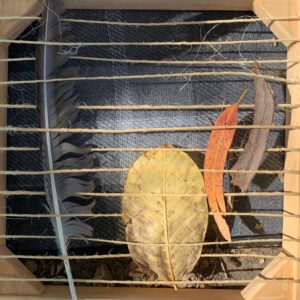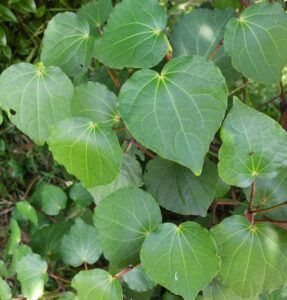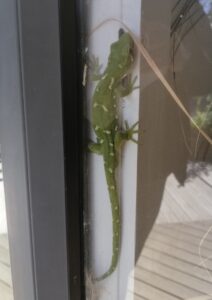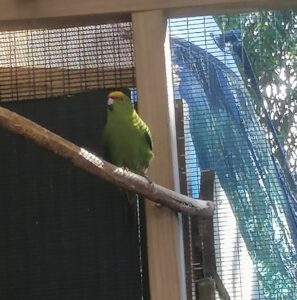The experienced Enviroschools Wairau Marlborough facilitation team provide a range of ways to engage and build depth and breadth of education for sustainability, taking on a community approach to delivering locally relevant opportunities.
101 workshop
Teacher workshops are an integral part of support provided by Enviroschools facilitators to empower others through the Enviroschools kaupapa. An Enviroschool is full of active learners developing skills, understanding, knowledge and confidence and working together to plan, design and create a sustainable place … but how do we get to that point?

Exploring the Enviroschools Guiding Principles.
Facilitators, Angela and Annie, recently ran an Enviroschools 101 workshop at Fairhall, just west of Blenheim, for those new to Enviroschools or wanting to know a bit more before stepping into a lead role for Enviroschools at their school.
Where was the best place to start? Out in the environment! Fairhall School was the background for our activities, noticing and observing te taiao in a slow and deliberate way, mapping what we found to build a puna mātauranga, pool of knowledge.
Creating a map is useful in many ways including prompting questions and wondering from students about their environment. The map and puna mātauranga with overlaid questions can form a basis for whole school strategies and core curriculum planning or the starting point for a student-led vision of how they and their community would like their school to look and feel like in the future.
Participants dived into the kaupapa of Enviroschools and Guiding Principles, exploring Fairhall School for special places, artwork, practices, spaces that reflected them.
Focusing on The Vision for Young People from Te Mataiaho showed how well aligned Enviroschools is with the curriculum refresh, confirming the richness of our Enviroschools Guiding Principles.
Each activity undertaken during the workshop helped build a resource for the teachers to use in their own schools with both staff and students.
Using the scenario of building a tunnel house/nursery at school to raise native plants for a riparian or ngahere planting, they explored how our Action Learning Cycle can be used for student inquiry learning as well as bigger whole school decision-making.
Part of the workshop focused on the wealth of online resources that are part of our support package. Kanohi ki te kanohi support includes help to plan and facilitate activities with staff and/or students, having an ‘expert’ on camp, connecting Enviroschools with local places, community organisations and events, and delving more deeply into the kaupapa and resources with the whole staff.
Even with a kete of activities, sometimes it is how you are supported that gives momentum to get up and running or for the motivation to keep going. The Enviroschools team is there to help.
Nature Connection Workshop
How often do you take the time to slow down and experience the environment with all your senses?
At the beginning of March, Marlborough Early Childhood teachers attending the Nature Connection workshop left feeling inspired and excited to plan their next excursion.

Creative expression.
Following on from the pilot programme last year where our Environmental Education team supported Spring Creek School and Springlands Kindergarten to set up their own Nature Connection programmes, they hosted an introductory workshop to Nature Connection.
Gathered at Sheps Park, Springlands Kindergarten teachers guided the group through the experience that they offer tamariki when they have their fortnightly visits there. Opening with a karakia, they then followed their process of a “safety check” walk around the boundary of the park. This is also utilised as an opportunity to role model intentional observation of the environment. Whilst walking, teachers were encouraged to collect an object that spoke to them. The objects were then used for a guided sensory activity that invited them to notice how it may change in different lights, how it felt on their hand vs their cheek, what it smelt like and how it sounded?
Utilising this object again, they were invited to be creative and create something with their item. These two experiences explored the first two Nature Connection Pathways of Contact and Beauty.
A series of brainstorms allowed teachers to unpack the 5 pathways to Nature Connection using in the UK Finding Nature – Nature Connection resource, and consider some other experiences that they could offer tamariki to strengthen their connection to nature.
“Senses, Beauty, Emotion, Meaning and Compassion”
Rongoā Workshop

The leaves of kawakawa are often eaten by a looper caterpillar. A chemical response to the damage contributes to its medicinal properties.
20 Marlborough teachers from Early Childhood to Secondary School gathered at Monkey Bay, Rarangi recently, for a Rongoā Workshop. As they arrived teachers were greeted by the glassy rolling swell of Tangaroa, the warmth of Tamanuiterā and the cool, refreshing presence of Tānemahuta. After a busy day in the classroom this warm welcome was the medicine needed to nurture a busy mind.
Hosted by the Marlborough District Council Environmental Education team as part of their PLACE focus this year, whaea Ripeka, whaea Tricia and whaea Lovey from Manaaki Ngahere Trust were invited to share some knowledge on rongoā plant identification.
This introductory workshop took kaiako on a guided walk into the surrounding bush to find a variety of plants with rongoā properties, such as kawakawa, harakeke, koromiko, ngaio, whauwhaupaku and the lichen angi angi.
Koru Native Wildlife Centre visit
As the clouds parted and the sun broke through, 15 ECE teachers descended upon Koru Native Wildlife Centre in Grovetown, North of Blenheim. This was the first event offered to Marlborough ECE teachers as part of the new Environmental Education support pilot for Early Childhood Centres.
In line with the regional focus of PLACE and CONNECTION this was an opportunity for teachers to meet educator, Ellen and see what resources she can support kaiako and tamariki with when learning about some of Aotearoa/New Zealand’s native species.
Koru Native Wildlife Centre invites you to get up close and learn about brightly coloured Yellow Crowned Kākāriki, fascinating Giant Weta and Marlborough Green Geckos and specialises in breeding and raising these threatened native species and growing native plants to provide a natural biodiversity for the wildlife.
They are set up to take guided tours with schools and ECE groups that want to learn interesting facts about the native animals and find out about the efforts to restore local natural habitats.

Up close to a gecko/ moko kākāriki.

kākāriki/ yellow-crowned parakeet at Koru Native Wildlife Centre.
Feedback to the workshop offerings has been that teachers have found them very informative. Many teachers would like to do plantings within their local environment and consult with their communities about the use of rongoā for minor applications.
Others found the knowledge particularly useful in order to talk with tamariki about the plants, for example kawakawa is the shape of a heart and is good for your heart, and that the kawakawa leaves with the holes have the highest healing properties as the plant has sent a lot of energy there – this can be related to our own well-being. One of the secondary schools is particularly interested in doing some follow up work with Ripeka. At this stage it is a watch this space to see how teachers apply this new knowledge.